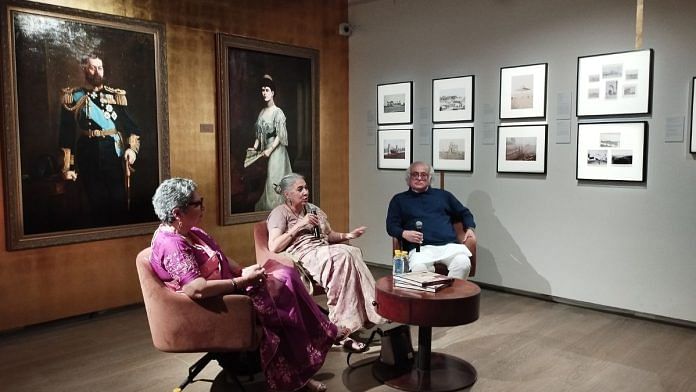New Delhi: In front of Jama Masjid’s minarets and dome, Viceroy Curzon is seated on an elephant and leading a procession of the 1903 Delhi Durbar. The chromolithograph on paper, which is on display at New Delhi’s DAG gallery, is more than just the British Empire flexing its muscle. Along with two other important British Durbars held in Delhi, it gives the viewer a peek into the power equations at the time.
In the years after the Indian Rebellion of 1857, when power was transferred from the East India Company to the British Crown, such displays were all the more significant.
“All three Delhi Durbars were held to promote British rule. Today, it is being seen from the Indian perspective,” said Rana Safvi in conversation with fellow historian Swapna Liddle and former Union minister and Congress leader Jairam Ramesh. The panel discussion was based on DAG’s ongoing exhibition, ‘Delhi Durbar: Empire, Display and the Possession of History’.
The first Durbar, held in 1877, declared Queen Victoria as the Empress of India, the second in 1903 marked King Edward VII’s succession, and the third in 1911 proclaimed King George V and Queen Mary as the Emperor and Empress of India.
While exploring DAG’s archive collection, the historians found many photographs, portraits, medals, maps, tickets, and programmes related to the three Durbars. The Durbars intentionally flaunted the might of the British—maharajas and nawabs were called to display their loyalty. The context of Durbars, which served as the intersection of political and theatrical drama, significantly influenced Indians and contributed to the enhanced popularity of colonial rulers, according to Safvi.
“It also tells the history of colonialism and how the British ruled India. In this context the role of Durbar becomes important,” Savfi added.
According to Liddle, the narrative of the ‘Coronation Durbars’ predominantly revolves around the central role of Delhi in the history of Indian empires. The British were compelled to grapple with this and ultimately recognise it. It’s what led to the transfer of the Indian empire’s capital from Calcutta (now Kolkata) to Delhi.
Also Read: Delhi is a city of ‘jalis’, not djinns. No other city has so many of them
Spectacle of Durbars
The colourful presence of maharajas and chiefs, bowing to the king, portrayed the monarch as a symbol of authority and the queen as “Kaiser-e-Hind” (Empress of India).
“Grand ceremonial Durbars used to take place [in Delhi]. It was a kind of spectacle in which first the Viceroy would arrive, followed by the King and Queen. In front of them were the ruling chiefs. When they bowed their heads, it enhanced the prestige of the British,” Safvi later told ThePrint.
Among the powerful elite who attended these Durbars were the Begums of Bhopal, who ruled the princely state from 1819 to 1926. Initially opposed to the East India Company, the Begums eventually accepted Queen Victoria as their model and inspiration.
According to Safvi, the Begums of Bhopal who attended the Durbars were notably pro-British, displaying no dichotomy in their allegiance. During the coronation of King George V in 1911, Shah Jahan Begum’s daughter Sultan Jahan attended the coronation of King George V in 1911, adorned in an Afghani burqa.
“Sultan Jahan Begum made the largest donation to Aligarh Muslim University, which enabled the establishment of that university. And she was also its first chancellor,” Safvi said.
But these displays stoked the flames of resistance on the ground. According to Ramesh, the 1911 Durbar witnessed a heightened sense of “nationalist sentiments” compared to the previous two ceremonies. This was expected, considering that by 1911, political sentiments had intensified. The Indian National Congress was 25 years old at that time.
Revolutionary Aurobindo Ghose and his brothers were among the key people who steered the nationalist movement in India between 1903 and 1911.
“This was not the Gandhian strive of the nationalism movement. This was the extreme of nationalist movement, which believed that the British must be tackled with violence… And they were freedom fighters in every sense of the term,” he added.
Ramesh went on to explain how the nationalist movement between 1903 and 1911 differed significantly from the post-1920 one. During this earlier period, there existed a robust streak of protest, agitation, violence, and other forms of resistance.
If the Durbars were about the politics of power, then the years that followed were about the decline and fall of empires.
(Edited by Ratan Priya)



